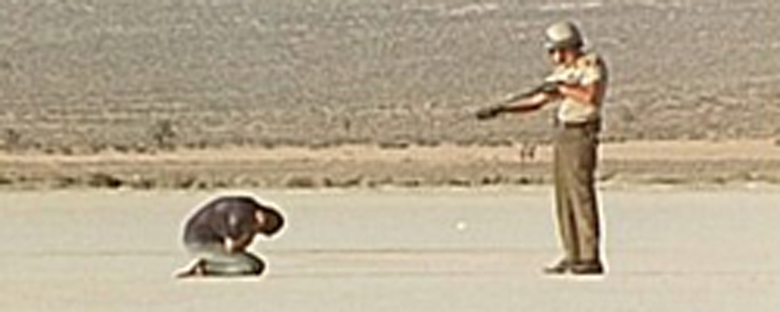Reviews
Peter Watkins
USA, 1970
Credits
Review by Leo Goldsmith
Posted on 19 June 2005
Source Project X Distribution DVD
Related articles
Features: The Radical Histories of Peter Watkins
Reviews: Edvard Munch
Upon its U.S. premiere, Punishment Park was greeted by The New York Times as “wrong-headed” and “paranoid,” and Watkins as a “masochist.” Other publications labeled it “offensive,” “hysterical,” and “part of the problem.” Released in a Murray Hill cinema in Manhattan, the film was withdrawn from its release after only four days (possibly for fear of drawing fire from local or federal authorities). And so, Punishment Park, widely maligned and discredited, has remained all but unseen in the United States for the last thirty-five years.
Given Punishment Park’s subject matter, one might assume that its time has passed and that its relevance has faded. Filmed in the U.S. in the midst of intense social and political unrest, the film is largely an indictment of the means with which the federal and local government suppressed opposition to the Vietnam War. Staging a clash between the sharply divided factions of Vietnam-era American society, the film draws upon much of the unease in the wake of the killing of anti-war protestors by the National Guard at Kent State University, and the police’s clubbing of protestors at the 1968 Democratic Convention in Chicago. The film also bases its tribunal sequences on the actual trials of such contemporary figures as Black Panther Bobby Seale, Joan Baez, LeRoi Jones, and the Chicago Seven. But Punishment Park’s broader concern is the treatment of insurrection in a democracy, and so the film is as widely applicable to our own factious state of the union as it was to that of America in the 1970s.
Like Watkins’ earlier “pre-constructions,” such as Privilege and The Gladiators, Punishment Park envisions a time in the “near future,” in which President Nixon employs the powers granted him by the 1950 McCarran Act, allowing the government to declare a state of emergency in which suspected dissidents (or even those who may become dissidents in the future) can be detained and prosecuted without recourse to legal representation or habeas corpus. These dissidents are separated into “corrective groups” and brought before a civilian tribunal where they are offered the choice of imprisonment or a three-day excursion in Bear Mountain National Punishment Park. In a grueling game of “capture the flag” used as a training exercise for law enforcement officers, the prisoners are let loose in the desert of Southern California and hounded by police officers and the National Guard. Ostensibly, the prisoners are not to be harmed by the authorities, but merely re-arrested once captured. But as the temperature point rises and aggression and frustration mount, some prisoners begin an aggressive counterattack on their pursuers, and the simple “training exercise” goes horribly, violently awry.
Punishment Park is Peter Watkins’ first full exercise in the form of collaborative filmmaking that would become his exclusive process for the remainder of his career. Working with only a very small crew of eight and a single 16mm camera, Watkins employed a cast of amateur actors to perform the roles of prisoners and authorities, many of whom were cast according to their actual experiences or political standpoints. The “corrective groups” in the film are composed of actual anti-war protestors and draft-evaders, many of whom draw upon the experiences of their own arrests; many of the members of the tribunal are civilians voicing their own opinions about the war and its protestors; and many of those portraying police officers were themselves once law enforcement officials. And in staging this conflict in the blazing heat of the San Bernadino desert, Watkins and his crew found themselves documenting an improvised mixture of real and fictional conflict. Indeed, Punishment Park is notable as the first of Watkins’ films to involve Watkins as an actual character, not a dry, mock-impartial observer (as in Culloden) but as an impassioned, even angry participant in the events onscreen.
Thirty-five years after its inauspicious release, it is still little wonder that Punishment Park drew the ire that it did. The film persistently works the raw nerves of its participants and elicits from them arguments and statements that are alternately impassioned, absurd, hysterical, and even caricatured. But this is not to say that the film is itself as hysterical or wrong-headed as early critics imagined. Rather the film is a direct, but wholly earnest provocation, an incitement to discourse that is incendiary only to the extent that it draws various political and social factions (pacifists, nationalists, revolutionaries, government authorities, union leaders, left-wing intellectuals, and even journalists) into a hitherto non-existent place for debate. And if the film seems paranoid or overblown in its depiction of a volatile time in American society, it is nonetheless important to note that Watkins himself described the film as a combination of realism and expressionism, that Punishment Park is in many ways a nightmare that one must wake up from to prove that it is not — or ought not be — true.
We don’t do comments anymore, but you may contact us here or find us on Twitter or Facebook.



